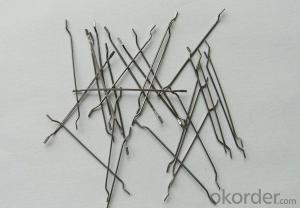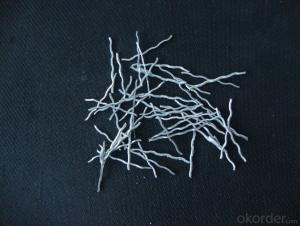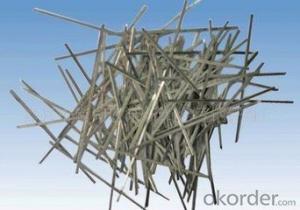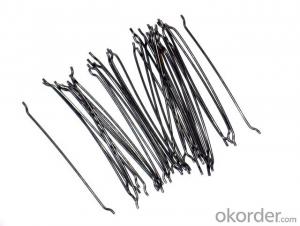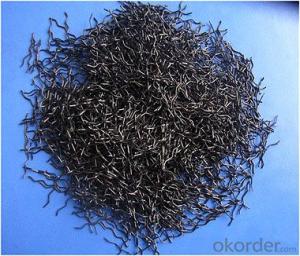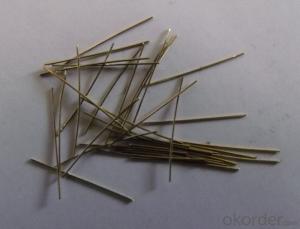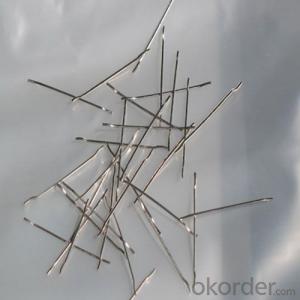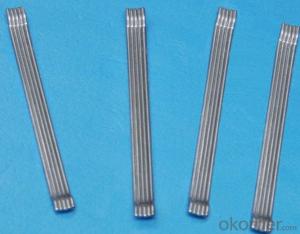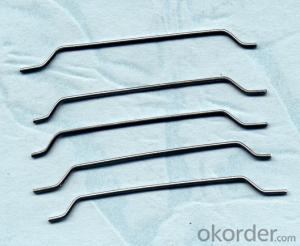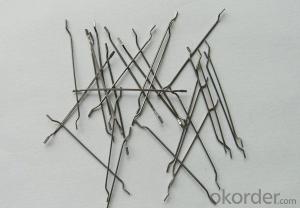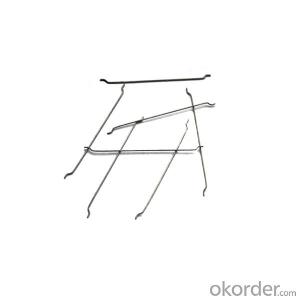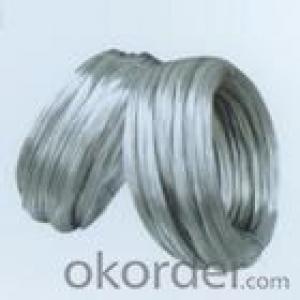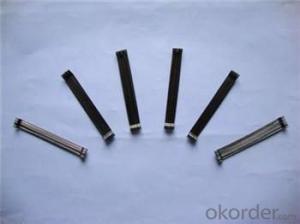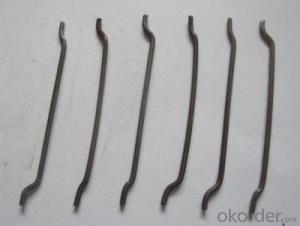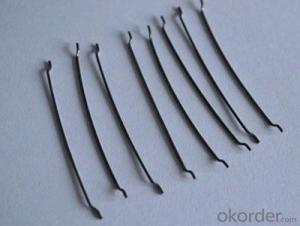Melt Extract Stainless Steel Fiber Straight Type CNBM from China
- Loading Port:
- Tianjin
- Payment Terms:
- TT OR LC
- Min Order Qty:
- 1000 kg
- Supply Capability:
- 30000 kg/month
OKorder Service Pledge
OKorder Financial Service
You Might Also Like
Quick Details
Place of Origin: Jiangsu, China (Mainland)
Model Number: HT-ST
Material: Steel
Specifications
Steel fibers today offer the designer and constructer state-of-the-art technology for use as reinforcement in many concrete elements and applications. There are many varieties of styles, shapes and sizes of steel fibers in the market today.
Introducing steel fibers into the concrete mix provide new mechanical properties. We now have a new material, with improved mechanical properties that can enhance structural applications. The fibers can be included as a substitute for the common steel reinforcement, or as a complement, or for a better performance for strain that the common reinforcement can't absorb.
In mechanical and performance terms, by adding steel fibers to the concrete mix you can:
Increase and get a stable of tensile strength under flexion load, which produces a ductile behavior
Increase impact resistance
Increase cyclic loads of resistance (fatigue effect)
Increase prevention of the plastic shrinkage crack
Increase the concrete performance against thermal variations
Get minor permeability
Picture
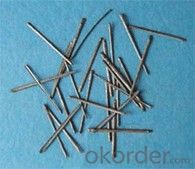
Steel fiber straight type

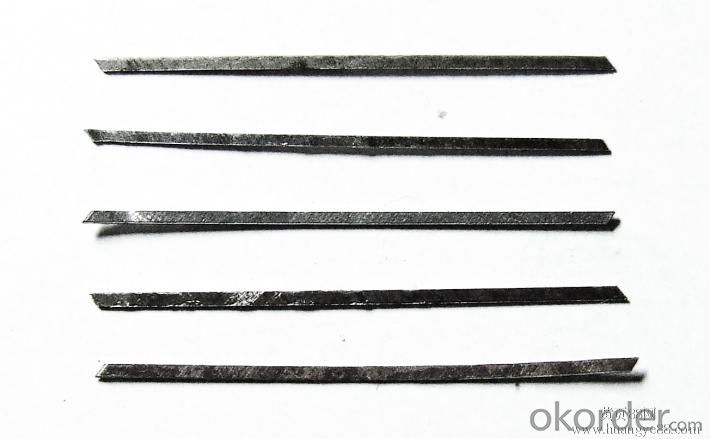
FAQ
certificated: ISO 9001
Technical advantages of Daye steel fiber:
A. Improve mechanical performance of concrete
B. Provide uniform distribution throughout concrete with excellent mixing
C. No balling or caking by adopt correct mixing method
D. Reduce concrete volume
E.Save construction time and cost
F.Reduce excavation volume
G.Available for jointless floor.
- Q: Can melt extract stainless steel fiber enhance the resistance of concrete to freeze-thaw cycles?
- Yes, melt extract stainless steel fiber can enhance the resistance of concrete to freeze-thaw cycles. Stainless steel fibers are known for their excellent mechanical properties and durability, making them an effective reinforcement material for concrete. When added to concrete, these fibers can improve its resistance to cracking, spalling, and deterioration caused by freeze-thaw cycles. During freeze-thaw cycles, water trapped within concrete can expand when it freezes, exerting pressure on the surrounding material. This can lead to the development of cracks and ultimately, the degradation of the concrete. However, the addition of melt extract stainless steel fibers can help mitigate this issue. The fibers act as reinforcement within the concrete matrix, improving its tensile strength and ductility. This reinforcement helps to distribute the stresses caused by freeze-thaw cycles more evenly throughout the concrete, reducing the likelihood of cracking. Additionally, the stainless steel fibers can also help to bridge any cracks that may form, preventing their propagation and minimizing the potential for water ingress. Furthermore, stainless steel is highly resistant to corrosion, which is a common concern in concrete exposed to harsh environments. The use of melt extract stainless steel fibers can significantly reduce the risk of corrosion-induced deterioration, ensuring the longevity and durability of the concrete structure. In conclusion, melt extract stainless steel fiber can indeed enhance the resistance of concrete to freeze-thaw cycles. By improving the concrete's tensile strength, ductility, crack bridging capability, and corrosion resistance, these fibers contribute to the overall durability and performance of concrete in freezing and thawing conditions.
- Q: Can melt extract stainless steel fiber be used in shotcrete tunnel boring machine applications?
- Yes, melt extract stainless steel fiber can be used in shotcrete tunnel boring machine applications.
- Q: How does the addition of melt extract stainless steel fiber affect the rheology of concrete?
- The addition of melt extract stainless steel fiber generally improves the rheology of concrete. Due to its high aspect ratio and small diameter, the fiber enhances the workability of the concrete mix, making it easier to handle and place. It also improves the flowability and cohesiveness of the concrete, reducing segregation and improving the overall homogeneity of the mixture. Additionally, the steel fibers help to increase the viscosity and yield stress of the concrete, resulting in improved resistance to cracking and enhanced durability.
- Q: What is the long-term performance of melt extract stainless steel fiber in concrete structures?
- The long-term performance of melt extract stainless steel fiber in concrete structures is generally favorable. Melt extract stainless steel fiber is known for its high tensile strength, corrosion resistance, and durability, making it an excellent reinforcement material for concrete. Over time, concrete structures can be subjected to various environmental and mechanical stresses, such as freeze-thaw cycles, chemical exposure, and heavy loads. Melt extract stainless steel fiber helps mitigate these issues by enhancing the overall strength and toughness of the concrete. The stainless steel fibers are evenly distributed throughout the concrete matrix, forming a three-dimensional reinforcement network. This network acts as a secondary reinforcement system, effectively reducing crack formation and propagation. As a result, the concrete structure becomes more resistant to cracking, shrinkage, and deformation. Furthermore, the corrosion resistance of melt extract stainless steel fiber ensures that the concrete remains protected even in aggressive environments, such as coastal areas or industrial settings. Unlike traditional reinforcement methods like steel rebar, stainless steel fibers do not rust or corrode, thereby preserving the structural integrity of the concrete over the long term. In terms of performance, melt extract stainless steel fiber has been extensively tested and proven to enhance the flexural and impact strength of concrete structures. It improves the resistance to fatigue, abrasion, and impact loads, making it particularly suitable for applications such as industrial floors, pavements, bridge decks, and precast elements. Overall, the long-term performance of melt extract stainless steel fiber in concrete structures is highly reliable. Its ability to reinforce and protect concrete against various stresses and environmental factors makes it an excellent choice for durable and long-lasting construction projects.
- Q: How does melt extract stainless steel fiber improve the resistance of concrete to chloride ingress?
- Melt extract stainless steel fiber plays a crucial role in enhancing the resistance of concrete to chloride ingress. When added to the concrete mixture, these stainless steel fibers provide a physical barrier that impedes the movement of chloride ions into the concrete matrix. Chloride ions are a leading cause of corrosion in reinforced concrete structures, as they penetrate the concrete and reach the steel reinforcement, leading to its corrosion and eventual degradation. This corrosion not only compromises the structural integrity of the concrete but also reduces its service life. The presence of melt extract stainless steel fibers in the concrete effectively reduces the permeability of the material, limiting the ingress of chloride ions. These fibers create a network within the concrete, forming a three-dimensional reinforcement system that restricts the movement of chloride ions. Additionally, the stainless steel fibers enhance the mechanical properties of the concrete, making it more resistant to cracking and spalling caused by chloride-induced corrosion. They improve the tensile and flexural strength of the concrete, minimizing the potential for crack formation and propagation. Furthermore, melt extract stainless steel fibers also act as a sacrificial anode, preventing the corrosion of the steel reinforcement. As the chloride ions come into contact with the stainless steel fibers, they are attracted to the fibers instead of the reinforcement, reducing the risk of corrosion. In summary, melt extract stainless steel fibers improve the resistance of concrete to chloride ingress by creating a physical barrier, reducing permeability, enhancing mechanical properties, and acting as a sacrificial anode. These fibers significantly extend the service life of concrete structures by mitigating the detrimental effects of chloride-induced corrosion.
- Q: What is the effect of melt extract stainless steel fiber on the fatigue behavior of concrete beams?
- Concrete beams benefit greatly from the addition of melt extract stainless steel fibers, as they positively impact the beams' fatigue behavior. Stainless steel fibers, known for their high tensile strength and resistance to corrosion, enhance the durability and performance of concrete structures when subjected to cyclic loading conditions. By acting as reinforcement, the stainless steel fibers evenly distribute stress throughout the structure when added to concrete beams. This reinforcement significantly improves the beams' fatigue resistance, enabling them to endure repeated loading and unloading cycles without incurring substantial damage or failure. The presence of stainless steel fibers in concrete beams also aids in reducing crack propagation and controlling microcrack growth. This is achieved by the fibers bridging across cracks, preventing their widening or further propagation. Consequently, the overall fatigue life of the beams is increased. Furthermore, the incorporation of melt extract stainless steel fibers enhances the ductility of concrete, rendering it more resistant to cracking and enhancing its energy absorption capabilities. This improved ductility contributes to the overall fatigue performance of the beams, allowing them to deform and absorb energy more effectively, thereby minimizing the risk of sudden failure. In conclusion, the addition of melt extract stainless steel fibers to concrete beams has a positive impact on their fatigue behavior. It improves fatigue resistance, reduces crack propagation, enhances ductility, and ultimately increases the overall durability and lifespan of the beams when subjected to cyclic loading conditions.
- Q: Can melt extract stainless steel fiber be used in self-compacting concrete mixtures?
- Yes, melt extract stainless steel fiber can be used in self-compacting concrete mixtures. The addition of stainless steel fibers enhances the properties of self-compacting concrete, such as improving its durability, crack resistance, and mechanical strength.
- Q: How does melt extract stainless steel fiber improve the ductility of shotcrete?
- The ductility of shotcrete is enhanced by melt extract stainless steel fiber, which improves its resistance to deformation and cracking. The inclusion of stainless steel fibers in the shotcrete mix forms a reinforced matrix that increases its tensile strength and flexural capacity. During the application of shotcrete, it undergoes a curing process that results in hardening and increased strength. However, shotcrete is susceptible to cracking when subjected to tensile stresses without any reinforcement. By integrating melt extract stainless steel fibers, the ductility of shotcrete is enhanced as the fibers distribute the tensile forces throughout the material, preventing the formation and spread of cracks. The exceptional properties of stainless steel, such as its high tensile strength and corrosion resistance, make it an ideal material for reinforcing shotcrete. The fibers are evenly dispersed within the shotcrete mix, creating a three-dimensional reinforcement system that improves its structural integrity. The addition of stainless steel fibers also enhances the overall durability of shotcrete. The fibers act as a barrier, preventing the entry of water and other harmful substances, thereby reducing the risk of corrosion and deterioration. This results in a longer service life and reduces the need for expensive maintenance and repairs. In conclusion, the presence of melt extract stainless steel fiber enhances the ductility of shotcrete by reinforcing its structure and improving its ability to withstand tensile stresses and deformation. Incorporating these fibers provides shotcrete with increased strength, durability, and resistance to cracking, ultimately enhancing its performance and extending its lifespan.
- Q: How much is the steel fiber bridge diversion dam using the model and specifications?
- Practice shows that the steel fiber reinforced concrete has the support of rapid, timely, the mechanical properties of concrete shotcrete layer and surrounding rock, good bonding strength etc., can solve the problem of cracks in reinforced concrete, the durability of the problem is difficult to solve, for tunnel engineering can greatly decrease the cost, in water conservancy and hydropower engineering has great application prospects
- Q: How does the addition of melt extract stainless steel fiber impact the curing time of concrete?
- The addition of melt extract stainless steel fiber to concrete can significantly impact the curing time. This type of fiber acts as a reinforcement in the concrete matrix, providing enhanced strength and durability. Due to its high thermal conductivity, the stainless steel fiber helps to dissipate heat generated during the hydration process, resulting in faster curing. This accelerated curing time can lead to earlier strength development and reduced overall construction time.
Send your message to us
Melt Extract Stainless Steel Fiber Straight Type CNBM from China
- Loading Port:
- Tianjin
- Payment Terms:
- TT OR LC
- Min Order Qty:
- 1000 kg
- Supply Capability:
- 30000 kg/month
OKorder Service Pledge
OKorder Financial Service
Similar products
Hot products
Hot Searches
Related keywords

